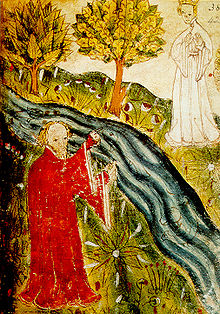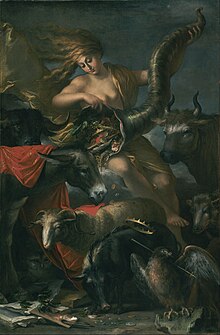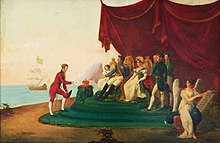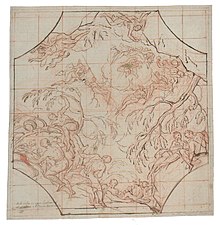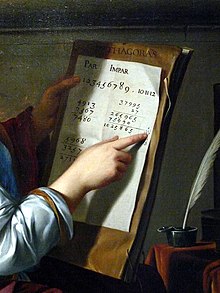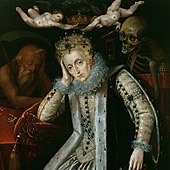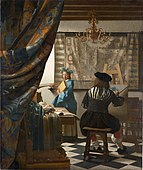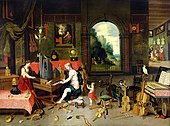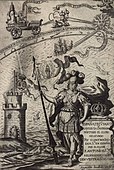Fire is one of the four classical elements along with earth, water and air in ancient Greek philosophy and science. Fire is considered to be both hot and dry and, according to Plato, is associated with the tetrahedron.

"Leaf by Niggle" is a short story written by J. R. R. Tolkien in 1938–39 and first published in the Dublin Review in January 1945. It was reprinted in Tolkien's book Tree and Leaf, and in several later collections. Contrary to Tolkien's claim that he despised allegory in any form, the story is an allegory of Tolkien's own creative process, and, to an extent, of his own life, following the structure of Dante's Purgatorio. It also expresses his philosophy of divine creation and human sub-creation. The story came to him in a dream.
The concept of an archetype appears in areas relating to behavior, historical psychology, and literary analysis.

Smith of Wootton Major, first published in 1967, is a novella by J. R. R. Tolkien. It tells the tale of a Great Cake, baked for the once in twenty-four year Feast of Good Children. The Master Cook, Nokes, hides some trinkets in the cake for the children to find; one is a star he found in an old spice box. A boy, Smith, swallows the star. On his tenth birthday the star appears on his forehead, and he starts to roam the Land of Faery. After twenty-four years the Feast comes around again, and Smith surrenders the star to Alf, the new Master Cook. Alf bakes the star into a new Great Cake for another child to find.

A parable is a succinct, didactic story, in prose or verse, that illustrates one or more instructive lessons or principles. It differs from a fable in that fables employ animals, plants, inanimate objects, or forces of nature as characters, whereas parables have human characters. A parable is a type of metaphorical analogy.

Logos is a term used in Western philosophy, psychology and rhetoric, as well as religion ; among its connotations is that of a rational form of discourse that relies on inductive and deductive reasoning.

Ancient Greek philosophy differentiates main conceptual forms and distinct words for the Modern English word love: agápē, érōs, philía, philautía, storgē, and xenía.

Pherecydes of Syros was an Ancient Greek mythographer and proto-philosopher from the island of Syros. Little is known about his life and death. Some ancient testimonies counted Pherecydes among the Seven Sages of Greece, although he is generally believed to have lived in the generation after them. Others claim he may have been a teacher of Pythagoras, a student of Pittacus, or a well-traveled autodidact who had studied secret Phoenician books.

A Greek–English Lexicon, often referred to as Liddell & Scott or Liddell–Scott–Jones (LSJ), is a standard lexicographical work of the Ancient Greek language originally edited by Henry George Liddell, Robert Scott, Henry Stuart Jones, and Roderick McKenzie and published in 1843 by the Oxford University Press.
Allegorical interpretation of the Bible is an interpretive method (exegesis) that assumes that the Bible has various levels of meaning and tends to focus on the spiritual sense, which includes the allegorical sense, the moral sense, and the anagogical sense, as opposed to the literal sense. It is sometimes referred to as the quadriga, a reference to the Roman chariot that was drawn by four horses.

Sophia is a central idea in Hellenistic philosophy and religion, Platonism, Gnosticism and Christian theology. Originally carrying a meaning of "cleverness, skill", the later meaning of the term, close to the meaning of phronesis, was significantly shaped by the term philosophía as used by Plato.
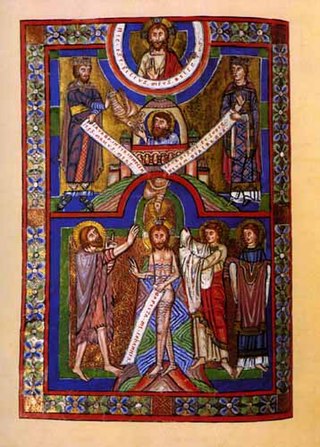
The four senses of Scripture is a four-level method of interpreting the Bible.

The Allegory of Love: A Study in Medieval Tradition (1936), by C. S. Lewis (ISBN 0192812203), is an exploration of the allegorical treatment of love in the Middle Ages and the Renaissance, which was published on 21 May 1936.
Anagoge (ἀναγωγή), sometimes spelled anagogy, is a Greek word suggesting a climb or ascent upwards. The anagogical is a method of mystical or spiritual interpretation of statements or events, especially scriptural exegesis, that detects allusions to the afterlife.
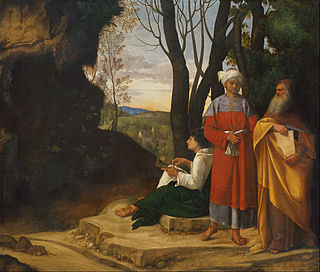
The Three Philosophers is an oil painting on canvas attributed to the Italian High Renaissance artist Giorgione. It shows three philosophers – one young, one middle-aged, and one old.
Theagenes of Rhegium was a Greek literary critic of the 6th century BC from Rhegium, in Magna Graecia.

In Ancient Greek religion and mythology, Cronus, Cronos, or Kronos was the leader and youngest of the first generation of Titans, the divine descendants of the primordial Gaia and Uranus. He overthrew his father and ruled during the mythological Golden Age, until he was overthrown by his own son Zeus and imprisoned in Tartarus. According to Plato, however, the deities Phorcys, Cronus, and Rhea were the eldest children of Oceanus and Tethys.

The One Ring, also called the Ruling Ring and Isildur's Bane, is a central plot element in J. R. R. Tolkien's The Lord of the Rings (1954–55). It first appeared in the earlier story The Hobbit (1937) as a magic ring that grants the wearer invisibility. Tolkien changed it into a malevolent Ring of Power and re-wrote parts of The Hobbit to fit in with the expanded narrative. The Lord of the Rings describes the hobbit Frodo Baggins's quest to destroy the Ring.

Many interpreters of Plato held that his writings contain passages with double meanings, called allegories, symbols, or myths, that give the dialogues layers of figurative meaning in addition to their usual literal meaning. These allegorical interpretations of Plato were dominant for more than fifteen hundred years, from about the 1st century CE through the Renaissance and into the 18th century, and were advocated by major Platonist philosophers such as Plotinus, Porphyry, Syrianus, Proclus, and Marsilio Ficino. Beginning with Philo of Alexandria, these views influenced the Jewish, Christian, and Islamic interpretation of these religions' respective sacred scriptures. They spread widely during the Renaissance and contributed to the fashion for allegory among poets such as Dante Alighieri, Edmund Spenser, and William Shakespeare.

Tolkien's Art: 'A Mythology for England' is a 1979 book of Tolkien scholarship by Jane Chance, writing then as Jane Chance Nitzsche. The book looks in turn at Tolkien's essays "On Fairy-Stories" and "Beowulf: The Monsters and the Critics"; The Hobbit; the fairy-stories "Leaf by Niggle" and "Smith of Wootton Major"; the minor works "Lay of Autrou and Itroun", "The Homecoming of Beorhtnoth", "Imram", and Farmer Giles of Ham; The Lord of the Rings; and very briefly in the concluding section, The Silmarillion. In 2001, a second edition extended all the chapters but still treated The Silmarillion, that Tolkien worked on throughout his life, as a sort of coda.
